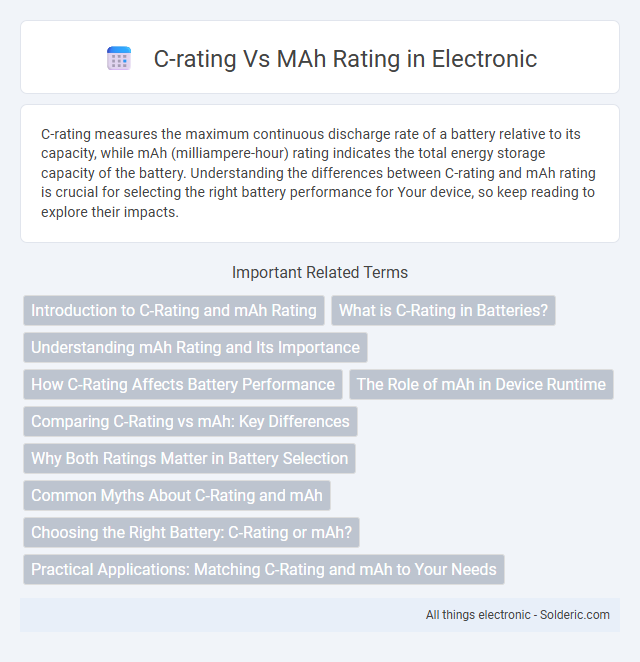C-rating measures the maximum continuous discharge rate of a battery relative to its capacity, while mAh (milliampere-hour) rating indicates the total energy storage capacity of the battery. Understanding the differences between C-rating and mAh rating is crucial for selecting the right battery performance for Your device, so keep reading to explore their impacts.
Comparison Table
| Aspect | C-Rating | mAh Rating |
|---|---|---|
| Definition | Discharge rate of a battery, indicating how fast current can be drawn (times capacity) | Battery capacity, representing total charge stored (milliampere-hours) |
| Unit | Multiplier (times the battery capacity) | Milliampere-hours (mAh) |
| Significance | Determines maximum continuous discharge current (C x capacity) | Defines total energy available for use before recharge |
| Example | 10C rating on 2000mAh battery allows 20A discharge current | 2000mAh indicates 2 Amp-hours capacity |
| Application | Important for high-drain devices like drones, RC cars | Important for estimating battery runtime and energy storage |
Introduction to C-Rating and mAh Rating
C-rating measures the maximum continuous discharge rate of a battery, indicating how quickly it can safely deliver current relative to its capacity. mAh rating defines the battery's capacity, representing the amount of charge it can store and provide over time. Understanding both C-rating and mAh rating is essential for choosing the right battery to meet your device's power and runtime requirements.
What is C-Rating in Batteries?
C-rating in batteries measures the maximum continuous discharge current relative to the battery's capacity, indicating how quickly a battery can safely deliver energy without damage. For example, a 10C rating on a 2000mAh battery means it can supply 20A (10 times 2000mAh) continuously. This rating is crucial for applications requiring high power output, ensuring efficient performance and longevity of the battery.
Understanding mAh Rating and Its Importance
The mAh rating, or milliampere-hour, measures a battery's energy capacity, indicating how long it can power a device before needing a recharge. Higher mAh ratings translate to longer battery life, making it a crucial factor when selecting batteries for your electronics. Understanding this rating helps you balance device performance and usage time efficiently.
How C-Rating Affects Battery Performance
C-rating determines the maximum continuous discharge rate relative to a battery's capacity, directly impacting how quickly power can be drawn without damaging the battery. Higher C-ratings enable your battery to deliver more current, improving performance in high-drain applications like drones or RC vehicles, while lower C-ratings may limit output and cause voltage drops. Understanding the balance between C-rating and mAh ensures your device runs efficiently and safely under varying load conditions.
The Role of mAh in Device Runtime
The mAh rating directly impacts your device's runtime by indicating the battery's capacity to store and deliver electrical charge over time. Higher mAh values generally translate to longer usage periods before needing a recharge, making this metric crucial for evaluating battery endurance. Understanding mAh helps you predict how long your device will operate under typical conditions, ensuring optimal performance and planning for power needs.
Comparing C-Rating vs mAh: Key Differences
C-rating measures the maximum continuous discharge rate of a battery relative to its capacity, indicating how quickly it can safely deliver current without damage. mAh rating represents the total charge capacity, showing how long a battery can power a device before needing a recharge. Understanding both ratings helps you select the right battery for your device's power demands and runtime requirements.
Why Both Ratings Matter in Battery Selection
C-rating measures the maximum continuous discharge rate of a battery relative to its capacity, indicating how quickly the battery can safely deliver current without damage. mAh rating represents the total energy storage capacity and determines how long a battery can power a device under a given load. Both ratings matter because selecting a battery with an appropriate C-rating ensures safe, efficient power delivery, while the mAh rating guarantees sufficient runtime for the intended application.
Common Myths About C-Rating and mAh
Many users mistakenly believe that a higher C-rating directly translates to longer battery runtime, when in fact, it indicates the maximum safe continuous discharge rate relative to the battery's capacity. Another common misconception is that mAh rating alone defines battery power, whereas it primarily measures energy storage capacity without reflecting how quickly the battery can safely deliver current. Understanding that C-rating and mAh address different performance aspects helps in selecting batteries suited for specific high-drain applications or extended usage.
Choosing the Right Battery: C-Rating or mAh?
Choosing the right battery hinges on understanding the difference between C-rating and mAh rating, where C-rating indicates the maximum continuous discharge current relative to the battery capacity, and mAh (milliampere-hour) measures the total energy storage capacity. Your choice depends on the application: high C-rating batteries deliver rapid bursts of power ideal for devices like drones or RC cars, while higher mAh batteries provide longer runtime suitable for less power-intensive usage. Prioritize C-rating for performance demands and mAh for endurance to optimize your battery's efficiency.
Practical Applications: Matching C-Rating and mAh to Your Needs
Choosing the right battery involves matching the C-rating and mAh capacity to your device's power requirements and usage duration. Batteries with higher C-ratings deliver greater current, essential for devices with high power demands such as drones or RC cars, while higher mAh ratings provide longer runtime for less power-intensive applications like handheld gadgets. Proper alignment of C-rating and mAh ensures optimal performance and battery longevity without risking damage from overcurrent.
C-rating vs mAh rating Infographic

 solderic.com
solderic.com